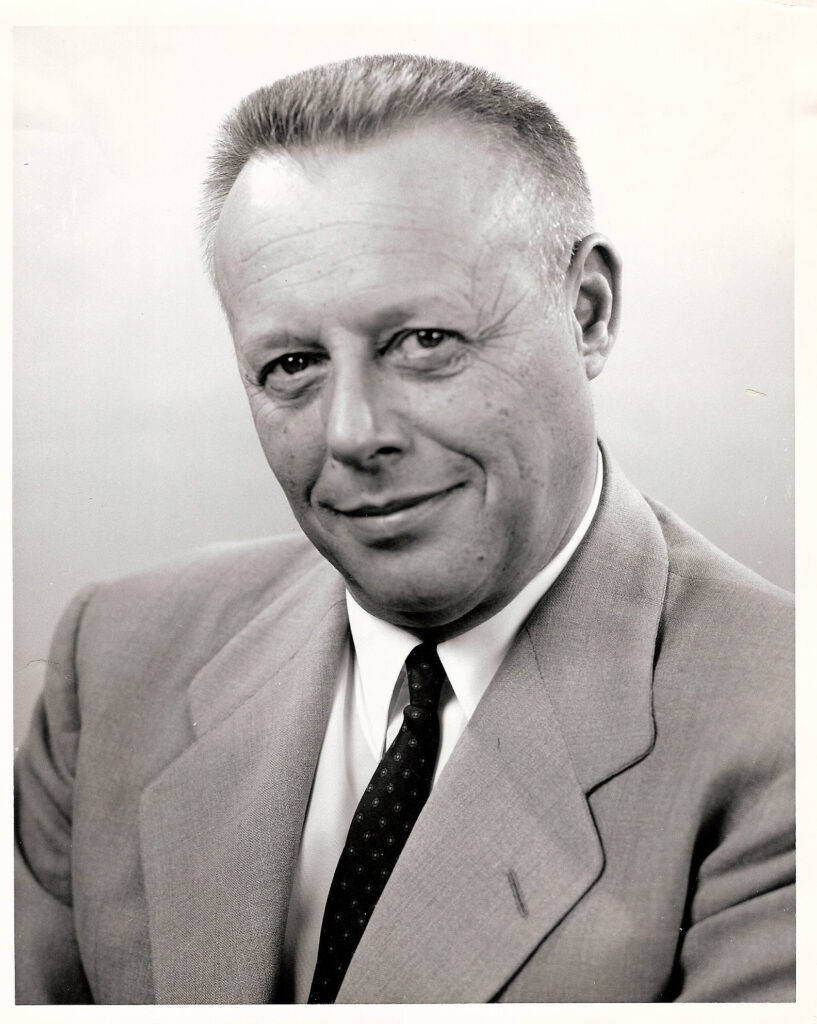Karel J. “Charlie” Bossart was involved in the early development of rocket technology with Convair Corporation. In 1946, he was largely responsible for conceiving the design of the propellant tanks, which served as the primary structure for the Atlas launch vehicle. The tanks were a unique design consisting of pressure-stabilized thin steel, a monocoque structure with a common inter-tank bulkhead, essentially a “steel balloon.” Bossart’s design has been called “one of those brilliant, innovative, and yet simple ideas, that have withstood the test of time as a major contribution to the advancement of astronautics.” Though the classified nature of much of his work at times obscured his importance, Bossart has been described as the “Chief Designer of the American Space Program,” comparable to his Soviet counterpart Sergei Korolev and NASA’s Wernher Von Braun.
Born in Antwerp, Belgium on February 9, 1904, Karel Bossart graduated from the University of Brussels in 1925 with a degree in mining engineering. In 1930, he won a scholarship to the Massachusetts Institute of Technology (MIT) from the Belgian-American Education Foundation, with the proviso that he learn English, which he did in just six weeks. At MIT he studied aeronautics, specializing in structures. He worked on avionics projects during World War II and by the war’s end he was Chief of Structures at Consolidated-Vultee Aircraft in California, (renamed Convair, now part of General Dynamics.)
In 1946, he took part in Project MX-774, the first US study of the German V-2 rocket, with the goal of producing America’s first intercontinental ballistic missile. Bossart emerged as the driving force that successfully transformed the MX-774 from a study to a vehicle test program, and when the Air Force requested that Convair develop a rocket with a 5100-mile range, he was placed in charge of developing ten MX-774 vehicles.
Karel Bossart proposed construction and testing in three developmental stages. Stage A, was a sub-sonic, self-navigational jet plane. Stage B was a test missile based on the V-2 used to test the final stage’s design. Stage C was to be the end result, an intercontinental ballistic missile with a range of 5100 miles. In 1947, however the MX-774 project was cancelled due to budget restrictions and resistance within the Air Force. Bossart was able to convince the Pentagon to complete the three vehicles for tests. Though the tests were less than satisfactory by their conclusion in December 1948, Bossart was able to demonstrate the viability of several design concepts including his most important innovation, pressurized, monocoque tanks.
After the Soviet Union detonated its first atomic bomb in 1949, America’s interest in the MX-774 project was rekindled. Karel Bossart helped revive the program in 1951 as Project MX-1593 with Convair getting the contract. Bossart renamed the system the “Atlas,” in honor of the mythological Titan who bore the weight of the world on his shoulders. In 1955, Bossart was named chief engineer of the Atlas project and two years later he was promoted to Technical Director of Aeronautics at General Dynamics. More than a decade of his work culminated in the first successful flight of an Atlas rocket on December 17, 1957. The next year Bossart received the Air Force’s Exceptional Civilian Award for his work in developing America’s first Intercontinental Ballistic Missile (ICBM). He also won the 1959 Collier Trophy for the U.S. Air Force and General Dynamics.
Karel Bossart was recognized as one of the finest technical men in the country and credited with spearheading a major advance in the art of rocketry, his use of a monocoque design (a construction technique that supports structural loads by using an object’s external skin) in which the rocket’s structural integrity was maintained by the pressure of the fuel. Thus the Atlas liquid propellant tanks served as both the primary vehicle structures and the propellant containers.
As a launch vehicle, the Atlas has formed the basis of the most successful and reliable expendable rockets in service. Atlas rockets were used to launch the world’s first communications satellite (Project SCORE in 1958); the first US orbital manned missions (Project Mercury, 1962); the Mariner probes to Venus (1962) and Mars (1964); and the Pioneer 10 and Pioneer 11 probes to Jupiter (1972) and Saturn (1973). The latest design derived from Bossart’s original, the Atlas V is still used by NASA and the Pentagon. Karel “Charlie” Bossart, widely acclaimed as “the father of the Atlas rocket” retired from General Dynamics in 1967. He died in San Diego, California on August 3, 1975

